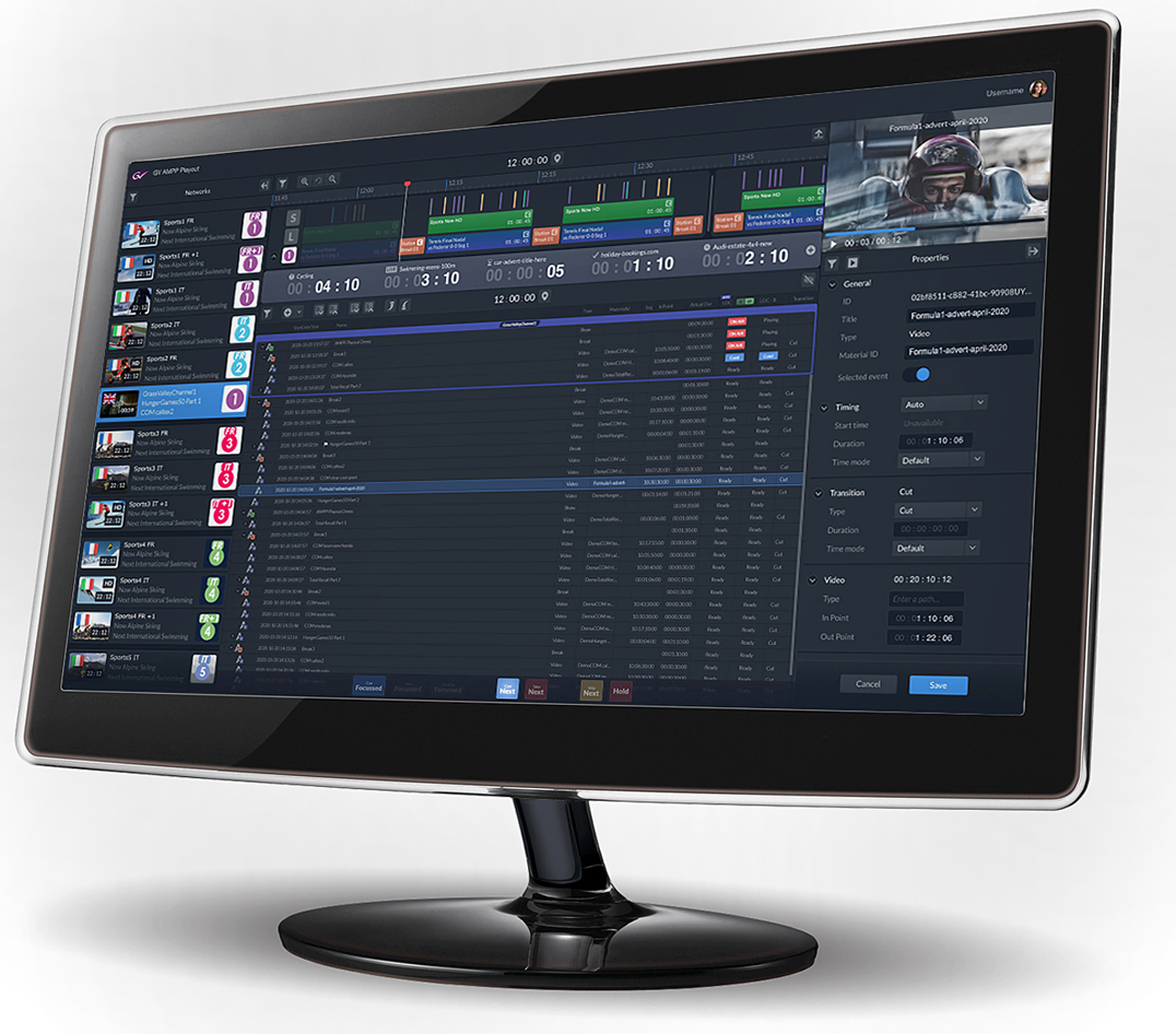Making the Cloud Work for Broadcast
‘The meaning of virtualized playout has changed significantly in the last 12 months’

ALEXANDRIA—Years ago, science fiction author Isaac Asimov said that although forward thinkers in the 19th century could imagine the automobile, they completely missed the necessity of parking lots. It wasn’t until we had experience with an increasing number of automobiles that the need to park them close to where you had business was obvious.
Deep thinkers in the mid-20th century could envision computer-to-computer communications, and by the 1970s the rudiments of what became known as “the internet” started to fall into place. By 2000 or so, use of the internet had become so common that files were described as being uploaded to the “internet cloud” in one location and downloaded in another.
However, this cloud was only for transport—it wasn’t until some forward thinker combined storage with the cloud that the power of the internet began to increase exponentially.
SPINNING UP
This brings us to the topic of virtual playout, a function that could not have existed 20 or possibly even 10 years ago.
“The meaning of virtualized playout has changed significantly in the last 12 months,” said Ewan Johnston, strategic partner and channel director for news at Dalet. “It is now considered synonymous with ‘cloud playout,’ with the benefits of rapid set-up, management from anywhere and an OpExmodel, enabling content creators to rapidly spin up new channels.”
How quickly can you “spin up” a new channel? “Broadcasters and rights holders now have the opportunity to play out content to their audiences with pop-up channels or feeds to social media outlets at any time,” said Karl Mehring, senior commercial director for playout at Grass Valley. “The speed and responsiveness of the cloud means that a team can engage with a major event or secure rights, or just have a brainstorm, then launch a TV channel in next to no time.”
The professional video industry's #1 source for news, trends and product and tech information. Sign up below.
SPEED & FLEXIBILITY
If you can think it, it can become an actual channel… perhaps by the end of the week.Besides the speed and flexibility of set up (which are no small benefits, of course), what else makes virtual playout a better mousetrap for broadcasters?
“Cloud playout can turn what has been a largely one-way street into an opportunity for conversation with the audience,” Mehring said. “Advertising and relevant information can be directed with great precision to relevant viewers and, with greater knowledge of the audience, new kinds of programming can be developed that would have been impractical with a wide broadcast approach.”
In addition to changing the interaction paradigm with viewers, virtual playout eliminates the capital expense, physical space and operating costs associated with master control facilities.
“It brings operational flexibility and ready scalability,” said Ignacio Revuelto Rosello, product marketing manager for Imagine Communications. “And it attempts to get rid of hardware dependencies. Given today’s hardware capabilities, it is best suited to handling transport streams rather than uncompressed, high-resolution video over IP.”
One of the most amazing points about virtual playout is that there can be (and almost certainly is) a channel that uses only compressed signals and never deals with the storage and bandwidth needed for uncompressed HD and UHD content.
DECISIONS, DECISIONS
If you have an existing broadcast distribution system, what questions should you ask if you’re thinking of replacing it (or adding to it) with a cloud-based system?
Start with defining the features and functions that drive your core business. How can you best monetize your content without ruining the user experience?
“Most broadcasters want to deliver the highest possible video quality,” said Rob Gambino, director of solutions at Harmonic. “They want richly branded channels with custom graphics, and many of them are now investigating personalization and regional variants to increase viewer engagement.”
Then look at complexity and price.
“Although traditional broadcast architectures are well understood, to move to a virtualized solution means adding an extra layer of computing overhead and intricacy for orchestrating hypervisors, VMs and virtual resources,” Rosello said. “Similarly, the cost of licenses for [the necessary software] plays a part in total cost of ownership.”
Finally, do you have a need for temporary channels?
“Broadcasters will often gain the right to broadcast major events where the ability to bring temporary channels to air is a must,” said Miroslav Jeras, chief technology officer at Pebble. “The Olympics are a great example of this where multiple sports are required to be broadcast concurrently, or elections where the results in each area of a country are being revealed at any one time.”
There are several companies with experience and products to address setup and operation of virtual playout systems.
LTN has a range of products, including LTN Transport, which provides predictable low-latency streams anywhere in the world, with dedicated support infrastructures that are often preferred by linear channel providers. LTN Schedule is a hosted playout platform that allows live and non-live elements to be managed across the same timeline with the flexibility to support a wide genre of channels, including entertainment, sports, esports, wagering, and news and information.
“For channels that include lots of live programming like sports and news, we’ve extended our centralized production service [LTN Flex] to help companies ramp up content production for full-time or pop-up channels,” said Rick Young, senior vice president and head of global products for LTN Global.
GV AMPP Playout is part of Grass Valley’s Agile Media Processing Platform application suite It’s a scalable cloud-first playout solution that lets users deploy any number of channels, where and when they need them, without requiring any additional infrastructure.
Imagine's Versio software-based playout engine is designed to operate in a private data center or in the cloud, providing video processing capabilities with peripheral functionality such as synchronizing video, audio and metadata, and inserting complex graphics in real time.
The Harmonic VOS360 cloud streaming platform is a managed solution that allows creation of linear channels, live events and streams. Using the platform, operators have control over content ingest, scheduling, playout, encoding, monetization and the creation of channel variants, with real-time agility.
Pebble’s Automation software platform provides centralized ingest, content management and multi-channel solutions, and can be scaled from one to hundreds of channels. The company’s Virtualized Playout solution is a software-only implementation of Pebble’s Integrated Channel device, and it is configurable for any channel whether it is IP or traditional SDI.
SECURITY IS PARAMOUNT
With anything on the internet, security is a paramount concern.
“There are two major aspects to consider regarding playout security,” Dalet’s Johnston said. “One is the security of the platform to allow a highly available service for premium SLAs. Second, the security of the content that is played out to ensure it is not leaked and distributed before the required playout date.”
Interestingly, being in “the cloud” may make operations more secure, not less. For example, an agreement with a cloud operator could require that all content and operational modules be stored in multiple locations, accessible with different passwords. A ransomware attack could be fended off by moving to the unaffected system.
“Cloud service providers such as AWS or Google have a huge amount of money to spend in security that far outweighs that of an individual broadcaster,” said Grass Valley’s Mehring. “They are trusted by banks and the stock market to run their systems, so platform security should not be an issue. We work closely with these companies to ensure that our products are architected from the ground-up with security in-mind.”
Mehring said that Grass Valley runs regular internal security checks within its CI/CD pipeline and employs data specialists to perform regular security penetration tests, all intended to provide better security than was possible in traditional on-premise systems.
WIDESPREAD INDUSTRY GROWTH
The sudden availability and growth of virtual playout systems does not immediately render physical broadcaster-owned playout systems obsolete, but it does provide a new distribution method that the clever and fleet-footed can exploit. With the Great COVID Panic of 2020-2021 forcing the general population into swiftly accepting virtual workdays and meetings, viewers are more primed than ever to accept new ways of enjoying their favorite content—and finding new favorite content.
“More and more media organizations are examining the merits and challenges of migrating their broadcast playout operations to IP and virtualized deployments,” said Pebble’s Jeras. “However, every broadcast playout workflow is unique, so properly supporting any broadcaster’s needs requires agile software development, a collaborative approach for the lifetime of the project and, crucially, an experienced engineering and deployment team.”
Bob Kovacs is the former Technology Editor for TV Tech and editor of Government Video. He is a long-time video engineer and writer, who now works as a video producer for a government agency. In 2020, Kovacs won several awards as the editor and co-producer of the short film "Rendezvous."




